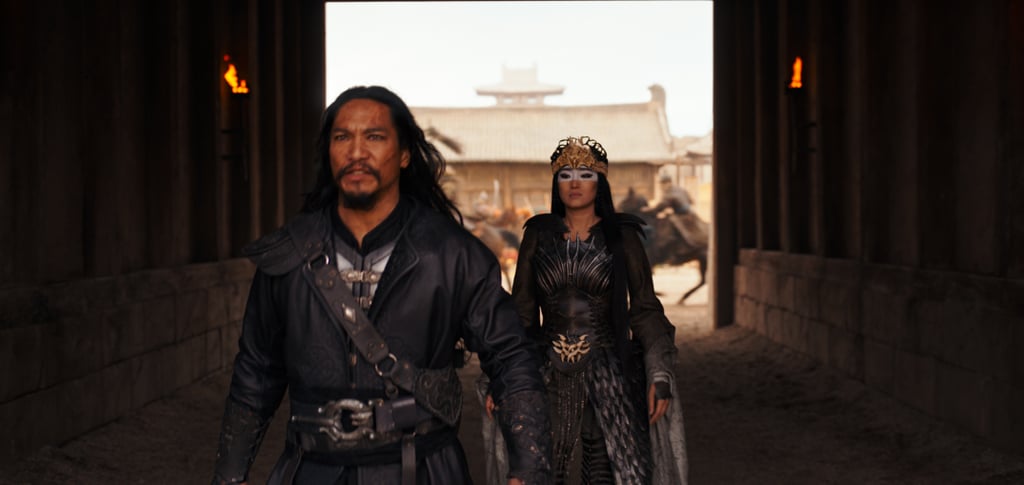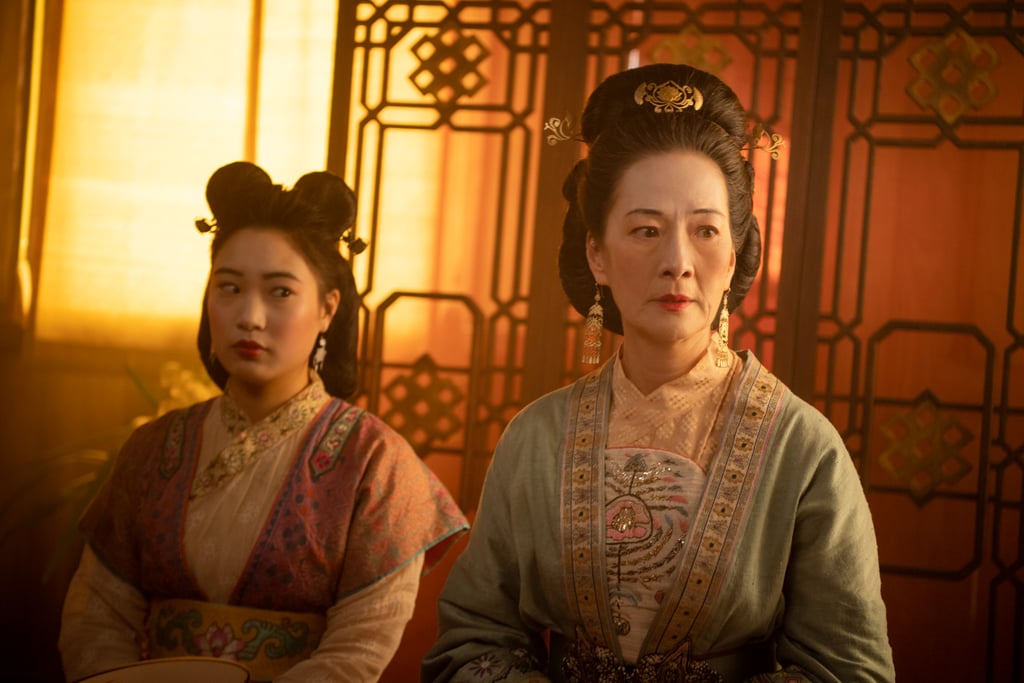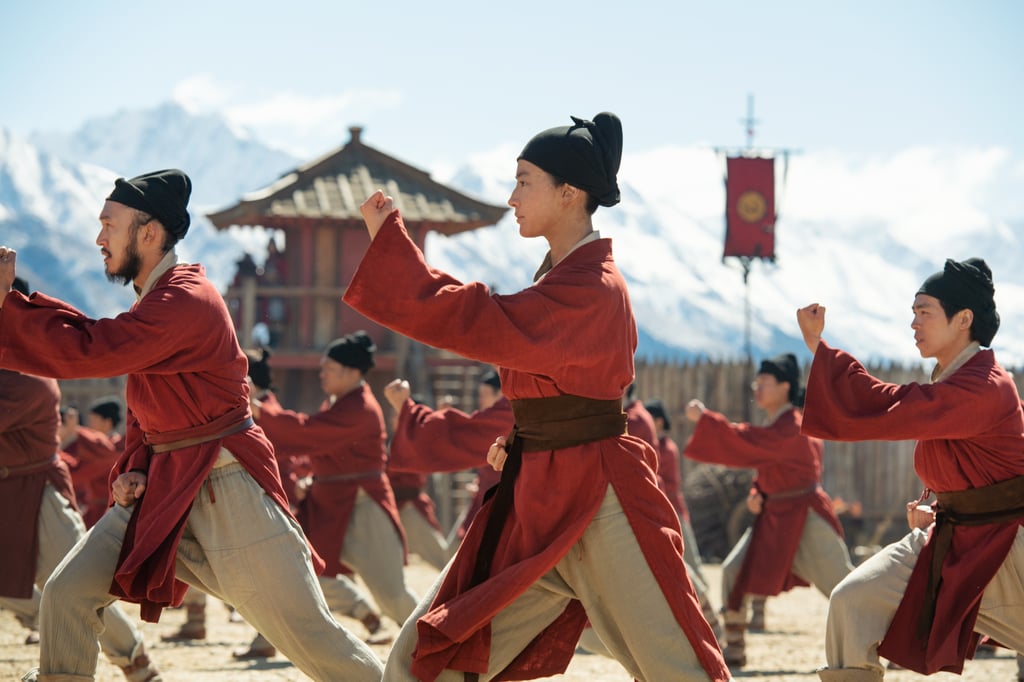We've been anticipating the release of Disney's live-action Mulan [1] ever since we caught word that it was in the works. Now that the premiere is finally here, we can't wait to see how this reboot takes the original animated story that we all know and love and transforms it into a larger-than-life live-action film. Judging by the official trailer [2], posters, and behind the scenes snapshots from filming, it's clear this is going to be a beautiful movie with elaborate hair, makeup, and costume designs [3].
Hair and makeup designer Denise Kum [4] had the all-important job of bringing the movie characters to life. Leading up to filming, she spent time researching China's rich history [5] and culture, specifically during the Tang Dynasty — the empire that Mulan's story is loosely based on — and allowed that to guide her hair and makeup decisions.
"We're not trying to be 100 percent historically accurate because we wanted to be able to have a little bit of fantasy in there as well," Kum told POPSUGAR. "You've got at once incredible naturalism and then you've got also this mysterious fantasy element which is much more a mix of incredible traditional elements of makeup and the idea of symbolism in Chinese."
Ahead, she talks about how she blended elements of fantasy with the Chinese culture and colour symbolism to create each of the characters' looks. (Spoiler alert: it involves some of your favourite retro Disney characters.)
While the 1998 film was referenced in the new movie, it wasn't followed as closely as some may assume. "We weren't really illustrating the original because that exists in its own right," she said. "There were key frames and images in the animation that informed some of the characters, but the makeup approach is not so much derivative, but more of a nod in the direction of the heightened colour palette and the brightness that you get with the animation."
To pay homage to the original film, director Niki Caro included a small detail that will make fans happy — if they catch it.
"We had Ming-Na Wen, who was the original voice of Mulan in the animation part one and two, do a cameo in our film," said Kum. "When you see the imperial scene where Mulan is being presented to the emperor, you see this beautiful woman come out and what is really quite lovely is it's almost like the voice of Mulan handing over the mantle to the new Mulan."
Out of everything, symbolism played the biggest part in Kum's decisions. "A lot of Chinese culture uses symbolism when it comes to colour and that was the main thing that informed the makeup for me," she said. "Every colour we used had a reason and a meaning within the Chinese culture, as well as how it worked aesthetically."
The primary colours [are] also redolent in animation and early Disney, made very Mickey Mouse and Donald Duck colours. I quite like that cross-cultural reference.
That's why you'll see a lot of red in the film — red symbolises good luck and is an important colour for the Chinese culture. "They're also primary colours. There's the white face powder, and then there are the slightly bluish eyebrows. There's the yellow forehead and the red lips and cheeks and markings on the forehead, which is a decorative element."
There's also a nod to early Disney animations in Kum's colour choices: "The primary colours also being very redolent in animation and early Disney, made very Mickey Mouse and Donald Duck colours. I quite like that cross-cultural reference between something being very essentialist and also something being very modern and very retro at the same time."
The larger-than-life characters in the film include the Matchmaker, Xianniang (the movie's primary villain), and Bori Khan, and that's shown in their hair and makeup designs.
"For the matchmaker, the hair ornaments, the size of the hair, and the more extravagant shapes were taken directly from what is replicated in a lot of the sculptures and the scroll paintings of that time," said Kum. "The looks are very lush and opulent. The hairstyles have much to do with class and wealth so these were intentionally decorative and very big."
Much of Xianniang's character, on the other hand, was mainly influenced by her animal reference. "Because she's a shapeshifter her animal reference is the hawk," said Kum. "So, the shape of the eye makeup and all the colours in her eye makeup were influenced by her costume, the armour, but also the hawk feathers."
The white mask across Xianniang's eyes, however, was a historic reference to clay figurines Kum found when researching. "I really liked how it was a white mask and, in many cultures, white is revered as something being beautiful. So, it was a bit of a way of a twist on that, layering that over her eyes."
On the opposite end of things, you have the men in the military that are made to be as realistic as possible. "Throughout Chinese culture, men at that particular period did not cut their hair because that was seen as disrespectful to one's ancestors and the symbolism of power," said Kum. "That meant that every single person had to have a wig because not very many men have long hair now. We tried to make them all look incredibly natural and real."
In order to help Mulan blend in as one of the men, Kum made each of the soldiers look slightly unique. "I had to make some of them a lot more feminine and some of them look more comedic — for lack of a better description, it's like the Seven Dwarfs," she said. "They all have their own exigencies and quirks and personalities, so there's variation within a strict uniform."
All in all, the movie takes you on a journey, much like the original Mulan did, and the hair and makeup show that. "We have to make her look incredibly natural as a young girl, then obviously there's a really over the top scene of her being presented in the matchmaking ceremony. That really helps us then to pivot to making her look much more androgynous, or boy-like. And then, obviously, revealing her true self as Mulan towards the end."
Personally though, what's even more important to Kum than that story itself is the meaning behind the story. "Even though this film comes from a long line of female-led stories within the Disney realm, she really is a warrior more than a princess."

![Out of everything, symbolism played the biggest part in Kum's decisions. "A lot of Chinese culture uses symbolism when it comes to colour and that was the main thing that informed the makeup for me," she said. "Every colour we used had a reason and a meaning within the Chinese culture, as well as how it worked aesthetically."
The primary colours [are] also redolent in animation and early Disney, made very Mickey Mouse and Donald Duck colours. I quite like that cross-cultural reference.
That's why you'll see a lot of red in the film — red symbolises good luck and is an important colour for the Chinese culture. "They're also primary colours. There's the white face powder, and then there are the slightly bluish eyebrows. There's the yellow forehead and the red lips and cheeks and markings on the forehead, which is a decorative element."
There's also a nod to early Disney animations in Kum's colour choices: "The primary colours also being very redolent in animation and early Disney, made very Mickey Mouse and Donald Duck colours. I quite like that cross-cultural reference between something being very essentialist and also something being very modern and very retro at the same time." Out of everything, symbolism played the biggest part in Kum's decisions. "A lot of Chinese culture uses symbolism when it comes to colour and that was the main thing that informed the makeup for me," she said. "Every colour we used had a reason and a meaning within the Chinese culture, as well as how it worked aesthetically."
The primary colours [are] also redolent in animation and early Disney, made very Mickey Mouse and Donald Duck colours. I quite like that cross-cultural reference.
That's why you'll see a lot of red in the film — red symbolises good luck and is an important colour for the Chinese culture. "They're also primary colours. There's the white face powder, and then there are the slightly bluish eyebrows. There's the yellow forehead and the red lips and cheeks and markings on the forehead, which is a decorative element."
There's also a nod to early Disney animations in Kum's colour choices: "The primary colours also being very redolent in animation and early Disney, made very Mickey Mouse and Donald Duck colours. I quite like that cross-cultural reference between something being very essentialist and also something being very modern and very retro at the same time."](https://media1.popsugar-assets.com/files/thumbor/_jpVN5TVbY4gstuM03m6_4B3S3g/fit-in/1024x1024/filters:format_auto-!!-:strip_icc-!!-/2020/09/03/897/n/1922153/d26c3d54e59d54df_PHO-09414_R/i/Out-everything-symbolism-played-biggest-part-in-Kum.jpg)



